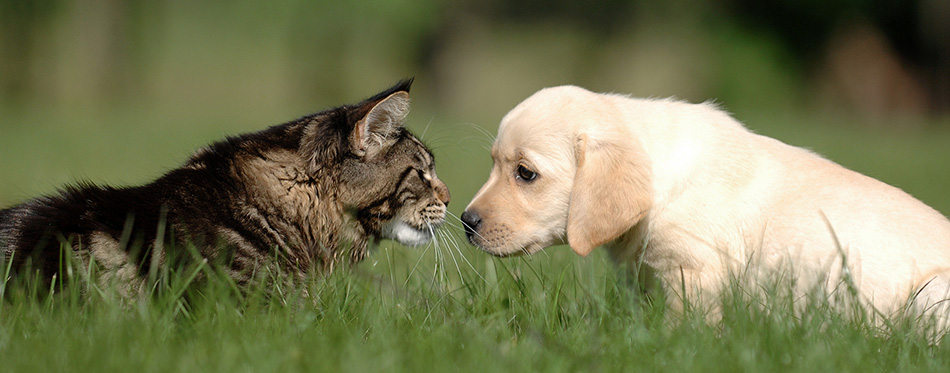While the fact that some people can be allergic to cats is common knowledge, pet to pet allergies, especially when it comes to your dog, are a little less known. But your dog can actually be allergic to your puss, just in the same way as humans. So, if you are a multi-pet household and your pooch has a tendency to sniffle when the family feline comes his way, then an allergy could well be the problem.
We take a look at what causes allergies, what are the symptoms if your dog is allergic to cats and what you can do about it.
What is an Allergy?
An allergic reaction occurs when your immune system – or that of your pet – reacts to a foreign substance that has entered the body. The allergen triggers an immune response, which can range from mild (think a stuffy nose, watery eyes or localized itching) to something much more severe, including anaphylactic shock, which can be fatal. Pollen, food and dust are amongst the main culprits, as well as animal fur and dander. Other environmental factors, such as smoke, perfume or mold can also be triggers. And just as you may be sensitive to any of these allergen triggers, then so can your dog.

Can a Dog Actually Be Allergic to a Cat?
While it is relatively rare for a cat to cause allergy problems in a dog, it can and does happen, especially if your pup is already showing signs of sensitivity to other environmental factors and allergens. It also depends on the type of cat you have as it is the fur and dander your feline sheds that can cause an allergic reaction, both in humans and dogs, although saliva can be a trigger too. There are some breeds of cats that are considered hypoallergenic due to their reduced ability to produce dander – cells that are shed from fur and hair – including Bengal, Burmese and Cornish Rex which are less likely to cause an allergic reaction.
What are the Symptoms?
In answer to the question – ‘is my dog allergic to my cat?’, if you do suspect a cat allergy reaction in your pooch, then you need to look out for the main symptoms.
The signs of a cat allergy in your canine can look very similar to other allergies, and in dogs will typically involve areas with less fur, such as their eyes, inner ears, mouth and abdomen, which are more exposed and so vulnerable to irritation. Symptoms of an allergic reaction in your dog include:
- Red, itchy and watery eyes
- Constant scratching of their skin
- Ear discharge
- Red, irritated or scabby/crusty skin
- Frequent licking, especially over a large area
- Rubbing their face or body on the carpet
- Some dogs may also show respiratory symptoms, such as sneezing or coughing.
What to Do If You Suspect an Allergy
If you suspect your dog may be allergic to your cat, it is worth monitoring their behavior for a short while, including how much time your two pets spend together, how your pooch reacts when in the company of your cat and whether their symptoms are acerbated when your feline is nearby. But when it comes to any potential allergy, the best thing you can do is take them to the vet for a definitive diagnosis. It may not be an allergy at all, but a reaction to fleas, ticks, insect bites, a respiratory infection or possibly ringworm – all conditions that can mimic the symptoms of a straightforward allergy. Your vet can also run a few tests to ascertain the specific cause of your dog’ allergic discomfort and confirm whether it is actually your cat or not. Once the source of the allergic reaction is known, you can take steps to minimize the impact on your dog.
Managing Your Dog’s Cat Allergy
So now it’s confirmed you have a dog allergic to cat situation, is there anything that can be done? While there are no real cures for allergies, there are medications that can manage your dog’s symptoms as well as simple steps you can take to minimize your dog’s exposure to the allergy trigger. And that doesn’t necessarily mean always keeping your pets separate or even getting rid of your cat to resolve the problem, unless your dog’s allergy is serious.
But before you make arrangements for you cat to live with someone else, your first step is to see what your veterinary professional recommends. For more serious allergies, they may suggest allergen-specific immunotherapy, where your dog is treated with a tailored allergy vaccine to build up their resistance to their specific cat-based trigger. This desensitization process can take several months, up to a year for the best results. Other options include antihistamines to help stop the irritation and itching.

At Home Treatments and Solutions
As well as following your vet’s medication and treatment plan, you can also make a few changes at home to keep your pooch calm and less reactive to those cat-allergy symptoms:
Boost your pooch’s natural skin resilience – supplementing his diet with Omega 3 fatty acids, especially eicosapentaenoic acid (EPA) can strengthen their healthy skin barrier.
Related Post: Fish Oils For Dogs
Keep your house clean – no, this is not a criticism, but you will need to be extra vigilant against the main allergy trigger, dander, around your home. Vacuum regularly, especially the rooms where your kit likes to roam, will reduce the amount of dander that is irritating your pooch. And don’t forget the couch, cushions and curtains as well as the floor.
Related Posts: Dyson Pet Vacuum and Vacuums for Pet Hair
Use an air purifier – used during the day, or when you need it, an air purifier will help to clear away any airborne dander particles in your home.
Bathe your dog regularly – keeping your pooch clean will help to rinse and remove any particles of dander that may be building up on their fur and skin. Bathe your cat too and get into a good habit of regularly grooming them outside to loosen and remove dander from their coat too.
Reduce their together time – while you don’t want to totally segregate them, especially if they are best buds, it may be wise to limit the time they are both in the same room and use a pet gate to keep them apart. At the very least, remove any cat paraphernalia such as scratching posts, toys and food bowl to another part of the house and out of your sensitive pooch’s way so domestic harmony and a less itchy skin for your dog is restored.

